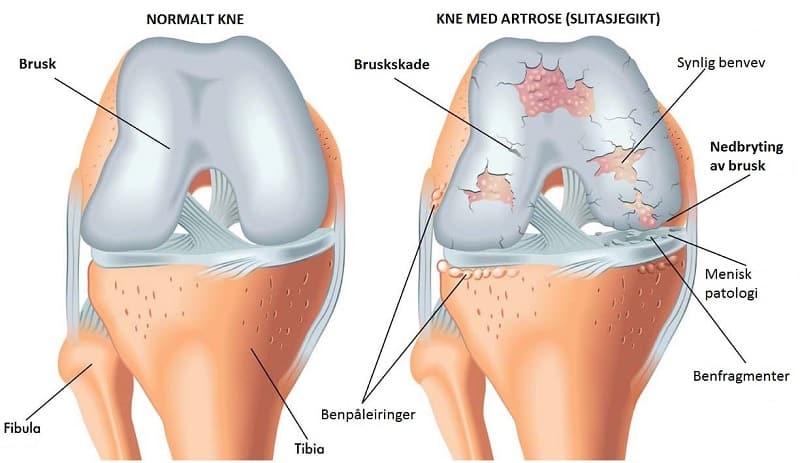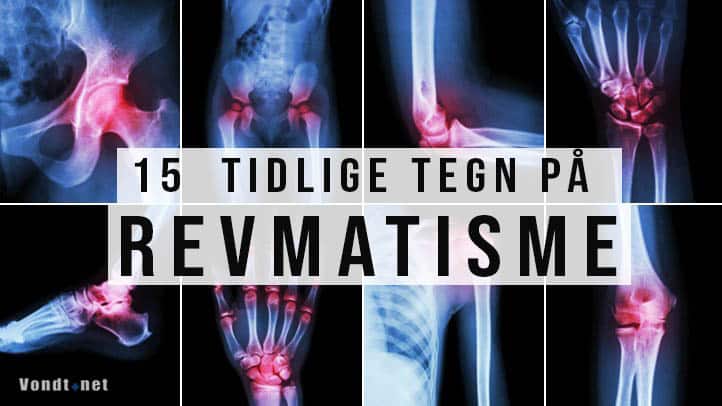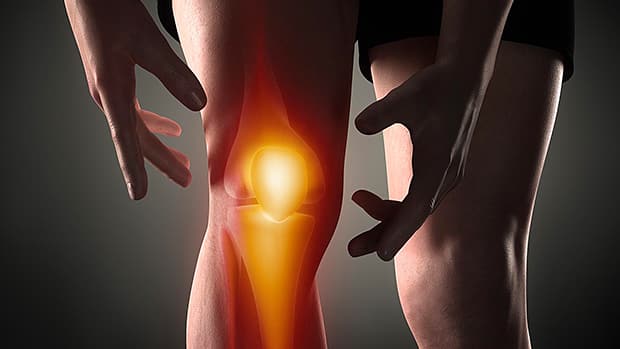
Pain On The Inside Of The Knee | Cause, diagnosis, symptoms, exercises and treatment
Pain on the inside of the knee? Here you can learn more about medial knee pain, symptoms, cause, exercises and diagnoses of pain on the inside of the knee. Follow and like us too Our Facebook page for free, daily health updates.
– Medial knee pain in the technical language
Are you suffering from pain on the inside of your knee? This is also known as medial knee pain in the technical language - where medial refers to the inside of the knee, i.e. where the knee is closest to your other knee. Such knee pain can occur in one knee or both - and is normally due to overload due to trauma or improper loading over a long period of time. If you have long-term pain on the inside of the knee, we strongly recommend that you have it investigated.
The Pain Clinics: Our Interdisciplinary and Modern Clinics
Our clinic departments at Vondtklinikkene (click here for a complete overview of our clinics) has a distinctively high level of professional expertise in the investigation, treatment and rehabilitation of knee diagnoses. Contact us if you want the help of therapists with expertise in knee pain.
Knee structure
The knee is a complicated structure composed of several parts, including tendons, ligaments, bursae, cartilage, meniscus and muscles. Due to its advanced structure, it is also the case that there are several possible causes and diagnoses that can be behind your medial knee pain. In the next paragraph, we will go into more detail about why you have pain on the inside of the knee and which diagnoses may be the cause.
Relief and load management for pain on the inside of the knee
Pain on the inside of the knee is an indication of improper loading or overload. Either way, it's a good idea to use one knee compression support to provide rest and relief to the painful area. The compression support contributes positively in several ways - including that it stimulates better blood circulation towards the injured and pain-sensitive areas of the knee. It can also be used preventively during sports and other stress.
Tips: Knee compression support (The link opens in a new window)
Click on the image or link to read more about the knee compression support and how it can help your knee.
Causes and diagnoses: Why do I have pain inside my knee?
As mentioned earlier, there are a number of causes that can be involved, partially or wholly, in your knee pain. Some possible causes of such pain inside the knee include:
Trauma
Injury to the knee can occur during falls, in sports or due to prolonged failure loads (for example, working on hard concrete floors for years). An example of an athletic injury is running on hard ground without adequate stability muscle in the hips and legs. In the absence of strength in this muscle, the strain may irritate the joints, cartilage, meniscus, tendons and ligaments. For example, running on asphalt can be thought of as a mild, repetitive trauma if you do not have the capacity to do this type of training.
In fact, the majority of functional knee problems are due to a lack of strength in the hip muscles. If you feel hit by this - then we can highly recommend these exercises.
Read more: - 6 Exercises for Stronger Hips

If you suspect a knee injury, we also strongly encourage you to have this investigated. Never let pain persist over time without getting a clinician to look at this - it's a bit like ignoring the warning light on the car; not fooled in the long run.
Bursitis of the knee (Mucosal inflammation)
A bursa, also known as a mucus bag, is a small fluid-filled structure that prevents the muscles, tendons and legs from rubbing against each other. The mucus pouches that can cause pain on the inside of the knee are the pes anserine mucosa and the infrapatellar mucosa.
If you have a trauma or fall to the knee, an inflammatory reaction may occur in this called bursitis. Such mucosal inflammation can cause local redness, swelling and significant pressure tenderness. The condition can also occur due to prolonged failure loads (for example, walking on hard surfaces without sufficient strength in the stability muscle).
Joint ligament injury on the inside of the knee
The medial ligament (medial collateral ligament) on the inside of the knee is a structure that has the task of stabilizing and protecting the knee from injury. Pain on the inside of the knee after a trauma to the outside of the knee may indicate an injury to the medial ligament - such an injury can vary in degree from stretching to partial or complete tearing.
If one is affected by such an injury, for example on the football field, then the knee will swell almost immediately after the trauma itself. With complete tearing, the pain, surprising to many, will often be less than partial tearing.
Meniscus injury (Meniscus rupture)

An injury or rupture of the medial part of the meniscus can cause pain on the inside of the knee. The medial part of the meniscus is the part of the structure that sits on the inside of the knee between the inner tibia and the femur.
The meniscus is like a medium-hard protective cartilage that protects the knee and connects the femur to the tibia. Damage to this cartilage can occur over a long period of time (for example due to being overweight) or it can occur in an acute manner (for example, during a football pitch).
A meniscus injury can be significantly improved with proper exercise and use of, for example, compression noise (link opens in new window) which increases blood circulation to the injured area.
Read more: meniscus (Meniscus damage)
Knee arthritis (wear of the knee joint)

- Here we see an example of osteoarthritis of the knee. Osteoarthritis mainly affects weight-bearing joints.
Wear in a joint is known as osteoarthritis (osteoarthritis). Such joint wear may occur due to failure or overload over time. An example may be due to compression of the knee joint due to overweight and lack of strength in the associated stability muscles of the hip, thighs and calves.
Knee osteoarthritis is common - and the more common the older you are. The vast majority of cases of osteoarthritis are asymptomatic, but in certain cases it can cause pain and cause functional compensation problems in associated structures.
With such wear and tear changes, it is common for the pain on the inside of the knee to be worse on the mornings and then to improve with movement.
Read more: Osteoarthritis (Osteoarthritis)
Medial plica syndrome
A synovial plica is a structure described as a folded membrane between the patella and the tibiofemoral joint. The vast majority of cases of plica are asymptomatic - and research has shown that almost 50% of us have them in the knee. We have four such structures in the knee:
Suprapatellar plica
Mediopathels plica
Infrapatella plica
Lateral plica
For pain on the inside of the knee, there is primarily tissue damage or irritation in the mediopatellar plica in question (ie the one located on the inside of the knee). Thus, the syndrome is that the folded membrane forms an unnatural tissue fold that can cause knee function to change and become painful. The condition can be treated conservatively with good effect.
Rheumatic arthritis
This joint disease is a form of rheumatism in which the body's own immune system attacks its own joints and weight-bearing structures. Such an autoimmune response occurs when the body's own defenses misinterpret its own cells as enemies or pathological invaders. In connection with the ongoing reaction from the immune system, joints may swell and become reddish in the skin. Eventually, the damage to bone structures and joints will be so extensive that it may in the worst case be necessary with a prosthesis in the knee or hip - therefore it is important to train preventively if you have been diagnosed with this condition.
Also read: 15 Early Signs of Rheumatism
Treatment of pain on the inside of the knee
As you have seen in this article, pain inside the knee can be caused by a number of different diagnoses - and therefore the treatment must also be tailored to the individual. A good start to get the right treatment is a thorough examination and clinical examination by a publicly authorized clinician with expertise in muscles, tendons and joints. The three professions with public health authorization with such expertise in Norway are physiotherapist, chiropractor and manual therapist.
Common treatment methods used for knee pain are:
- Physical treatment: Trigger point therapy (muscle knot therapy), massage, stretching and stretching are all parts of the umbrella term of physical therapy. This form of treatment aims to reduce soft tissue pain, increase local blood circulation and remodel tense muscles.
- Joint Mobilization: If your joints are stiff and hypomobile (not moving), then this can lead to a changed gait, incorrect movement pattern (for example that you look like a robot when you do something physical) and hence also irritation or pain in the associated musculature and soft tissue. A chiropractor or manual therapist can help you promote normal joint function, as well as help you with sore muscles and tendon injuries.
- Training and training: As mentioned earlier, it is extremely important to strengthen the hip muscles, as well as local knee muscles, to be able to withstand more strain and thus reduce the chance of relapse or aggravation of the pain. Based on a clinical examination, a clinician can prepare a training program tailored to you and your muscular imbalances.
Summarizeringing
Pain on the inside of the knee can be caused by a number of causes - which should often be examined by clinicians and then addressed in order to avoid further injuries to the knees. We place special focus on increased training of the hips and thighs when it comes to prevention and treatment of medial knee pain.
Do you have questions about the article or do you need more tips? Ask us directly via our facebook page or via the comment box below.
Recommended self help
Knee compression support: This helps to increase local blood circulation to the knee, thus increasing the region's healing response and repair ability. Can be used preventively and against active damage.
Read more here (opens in new window): Knee compression support
Exercise and Exercises for Pain on the Inside of the Knee
Exercising nearby stability muscle can help the body relieve cartilage, ligaments, meniscus and tendons. By training both strength in nearby muscles, as well as regularly performing movement exercises - such as those shown below - you can maintain good blood circulation and muscular elasticity. We recommend that you try to do these, or similar, exercises daily.
Are you affected by osteoarthritis of the knee joints? Then, as shown in the video below, these exercises are ideal for you.
VIDEO: 6 Exercises against Significant Knee Arthrosis (Advanced Osteoarthritis of the Knees)
Feel free to subscribe our YouTube channel (click here) for more free exercise programs and health knowledge.
It is also very important to recognize that a good hip function is essential to properly load the knees. Therefore, it is important that you also do the exercises shown below in this video as well.
VIDEO: 7 Exercises against Osteoarthritis / Wear in the Hip and Knee
Feel free to subscribe our YouTube channel (click here) for more free exercise programs and health knowledge.
NEXT PAGE: - This You Should Know About Knee Pain
Click on the image above to proceed to the next page.
 Follow Vondt.net on YOUTUBE
Follow Vondt.net on YOUTUBE
(Follow and comment if you want us to make a video with specific exercises or elaborations for exactly YOUR issues)
 Follow Vondt.net on FACEBOOK
Follow Vondt.net on FACEBOOK
(We try to respond to all messages and questions within 24-48 hours. We can also help you interpret MRI responses and the like.)







Leave a reply
Want to join the discussion?Feel free to Contribute!